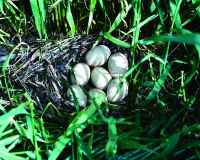| |
Beneficial Management Practices: Environmental Manual for Crop Producers in Alberta - Wildlife Habitat | |
| |
|
|
| |
|
|
| | Agriculture relies on a diversity of biological and natural resources to sustain key functions of agro-ecosystems in support of food production and security. Conserving and restoring wildlife habitat contributes to biodiversity and to the ecological functions on which agriculture depends such as:
- protection of water quality
- regional water cycling
- nutrient cycling
- maintenance of soil fertility
- pollination
- pest control
- climate regulation
Agricultural ecosystems (or agro-ecosystems) are ecosystems used for agriculture. Each species in an agro-ecosystem is part of a web of ecological relationships connected by flows of energy and materials. Farmers and ranchers manage this flow. Along with their environmental benefits, healthy, diverse habitats provide recreational, economic and quality of life benefits for farmers and rural communities.

Fall rye cover provides nesting habitat.
Courtesy of DUC
Factors affecting habitat on crop land:
- Agricultural practices that protect soil, water and air quality also help maintain habitat. These include such practices as reducing tillage, maintaining perennial cover, planting winter cereals, maintaining buffer zones along streams and lakes, planting shelterbelts and preventing spray drift.
- Draining or infilling wetlands, whether they are permanent or temporary, reduces habitat.
- If not properly managed, pesticide applications can harm non-target plants and animals.
- Some land uses can fragment natural landscapes, reducing habitat quality by reducing the ability of wildlife to move from one area to another.
Back to Chapter 2 - Environmental Considerations |
|
| |
|
|
| |
For more information about the content of this document, contact Roger Bryan.
This document is maintained by Jennifer Rutter.
This information published to the web on November 1, 2004.
Last Reviewed/Revised on October 30, 2017.
|
|